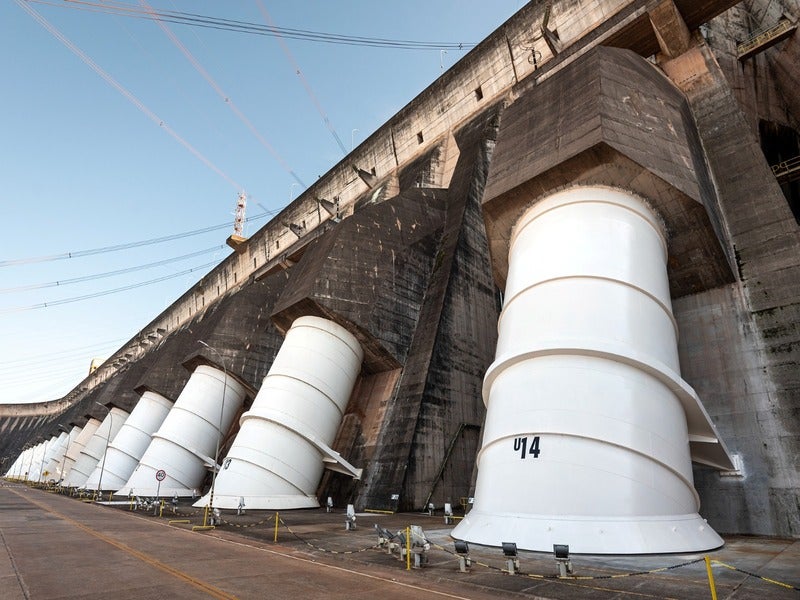Itaipú Hydroelectric Project is located on the Paraná River on the border between Brazil and Paraguay.
In May 1974, Itaipu Binacional, a Binational company was established to develop and operate the hydroelectric project.
Considered the world’s second-largest hydroelectric power plant, the Itaipu project can produce 14,000MW (14GW) of power.
Construction of the project commenced in 1975 and the hydroelectric project was officially inaugurated in October 1984.
The project has been supplying more than 13% of the Brazilian electricity demand and 90% of the Paraguayan electricity consumption in the last 10 years.
The hydroelectric project has generated approximately 2.9 billion megawatt-hours since the start of its operations.
Itaipu Project History
In April 1973, the Brazil and Paraguay governments signed the Treaty of Itaipu for the exploitation of the Paraná River for hydroelectric power.
In February 2023, the last instalment of the loans taken for the construction of the Itaipu Hydroelectric Power Plant was paid.
On November 10, 2023, Itaipu Binacional announced that the project has exceeded the 2022 production of 69.9 million MWh.
Itaipu Hydroelectric Project Development
The Itaipú reservoir was formed in 1982 and extends 170km in length with a total flooded area of 1,350 km2.
From 1975 to 1978, the Paraná River diversion channel was excavated, the rockfill dam was built, the industrial job site, the control structure and main cofferdams were built, and the river was diverted from its natural bed. Approximately 12.7 million m3 of concrete were used in the project construction.
The entire Itaipú dam spans nearly 8km long. The maximum discharge capacity of the dam’s spillway is 62,200 cubic meters per second. The total length of the dam is 7,235 metres and the crest elevation is 225 metres.
The project is equipped with 20 generating units providing 700 MW each with a hydraulic design head of 118m. Ten generators operate in 50 Hertz, the utility frequency used in Paraguay and the other 10 generators operate in 60 Hertz, the frequency used in Brazil.
The first two generating units were installed in 1984. The last two units commenced production in 2006 and 2007 respectively.
In 2016, the Itaipu project became the first hydroelectric plant to produce 103,098,366 MWh.
Power Transmission
Furnas Centrais Elétricas and ANDE (Administración Nacional de Electricidad) are respectively responsible for transmitting power to the load centres in Brazil and Paraguay.
Power from the project is sent to Brazil via the Furnas Transmission System, comprising five transmission lines, three of them in alternating current (AC) (60 Hz) and two in direct current (DC).
The renewable electricity is sent to the state of São Paulo, to the Tijuco Preto and Ibiúna substations and then joins the Brazilian interconnected system to be distributed.
The AC circuit has a substation in Ivaiporã, Paraná, which allows bidirectional exchange of power from southern Brazil if necessary.
The DC electricity is converted into AC at the Ibiúna Substation, São Paulo before it connects to the Brazilian interconnected power system.
Contractors Involved
In November 2018, a consortium established by GE Power and CIE Sociedad Anonima was selected by Itaipu Binacional to provide electrical equipment for the early stages of the modernisation project of the Itaipu Dam.
Under the three-year modernisation contract, GE was responsible for upgrading 24 overhead cranes, required to lift hydro turbines for modernisation.
GE’s scope of work includes providing AC motors, low-voltage drives and programmable logical controllers and encoders, to extend the overhead cranes’ lifetime for another 20 years.
In May 2022, GE Renewable Energy’s Hydro and Grid Solutions signed a contract to technologically upgrade the Itaipu hydropower plant.
The contract includes upgrading equipment and systems of all 20 power generating units and the hydropower plant’s measurement, protection, control, regulation and monitoring systems.
Under the contract, GE will be responsible for the supply of medium voltage cubicles, energy management systems, automation technology, protection, control and supervision systems for the generating units, GIS substation and the existing 500 kV transmission lines, two new compact GIS substations to increase the reliability of the project electrical auxiliary services.





